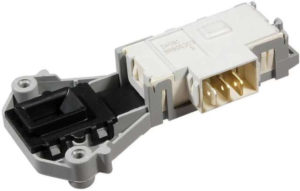 To prevent the door from opening during a washing program, any automatic washing machine is equipped with a washing machine hatch locking device. The locking is activated when the required program is set, the hatch door is closed and the start button is pressed. The stopper is switched off only after the program is completely completed.
To prevent the door from opening during a washing program, any automatic washing machine is equipped with a washing machine hatch locking device. The locking is activated when the required program is set, the hatch door is closed and the start button is pressed. The stopper is switched off only after the program is completely completed.
This measure is provided to primarily protect children from the possibility of injury from a rapidly rotating drum.
Thermal blocking and its structure
The operation of the device depends on the resistor. As heating increases, its resistance also increases. This effect is the reason for the deformation of bimetallic plates. When the program begins, an electric current passes through the thermoelement and the plate bends, heating up, closing the contacts in the microcircuit.

At the same time, the latch moves, which secures the hatch door. The washing machine only needs a few seconds to complete this algorithm.
Reasons for device failure
During operation of the washing machine, two reasons for the breakdown of the locking device may occur.
- Physical wear of the plates. Such a device is designed only for a certain number of switching and switching operations. Exposure to high temperatures and deformation during the execution of the program each time make the bimetallic plates thinner and weaker.
- The plates may lose their properties or even collapse in the event of a power surge.
Faulty mechanism will not allow you to open the machine door at the end of the wash, or will not be able to prevent it from opening during operations. Door locked for more than five minutes after cycle ends indicates that there is a malfunction in the blocker and the need to replace it.
Otherwise, a malfunction of the holding mechanism will prevent the program from starting. When such a problem occurs, it is difficult to find out its actual cause. But checking the performance of only the heating element is impossible. Therefore, it is necessary to dismantle the thermal blocker.
Thermal lock repair
The only way to replace the mechanism is to completely replace the lock. You need to prepare a Phillips screwdriver and pliers.

- Remove the clamp from the cuff.
- Unscrew the screws on the lock hole.
- Place your hand between the front cover of the machine and the sealing cuff and remove the lock.
Installation is in the reverse order.
A heavy drum may make it difficult to remove the lock. To make the task easier, you can tilt the entire machine back. This way, there will be no pressure on the cuff and the lock can be easily removed or installed.
What to do if the hatch is blocked due to a malfunction
- You can try running any short program, it could be a spin or rinse. Upon completion, the blocker will again be disconnected from the electric current and, perhaps, the bimetallic plates will be able to return to their original position.
- If after ten minutes of waiting the hatch still won't open You can try disconnecting the entire device from the electrical network and turning it on again. After the power to the automatic device has been turned off, the system will reboot and, possibly, the door will open.
- If none of the above tips help, then you can try one more chance. All washing mashines have a special cable for emergency door opening. It can be found on the lower front panel of the equipment where the filter is located, and in older models such a cable is located at the top. To the right or left of the filter you can find a red or orange cable. You don't need to pull it hard, just a little force is enough for the hatch to open.
If you have any doubts about the possibility of replacing the device yourself, it is better to also contact a specialist. An incorrectly installed lock and blocker can quickly fail, and a loose clamp on the sealing collar can lead to water leakage.









